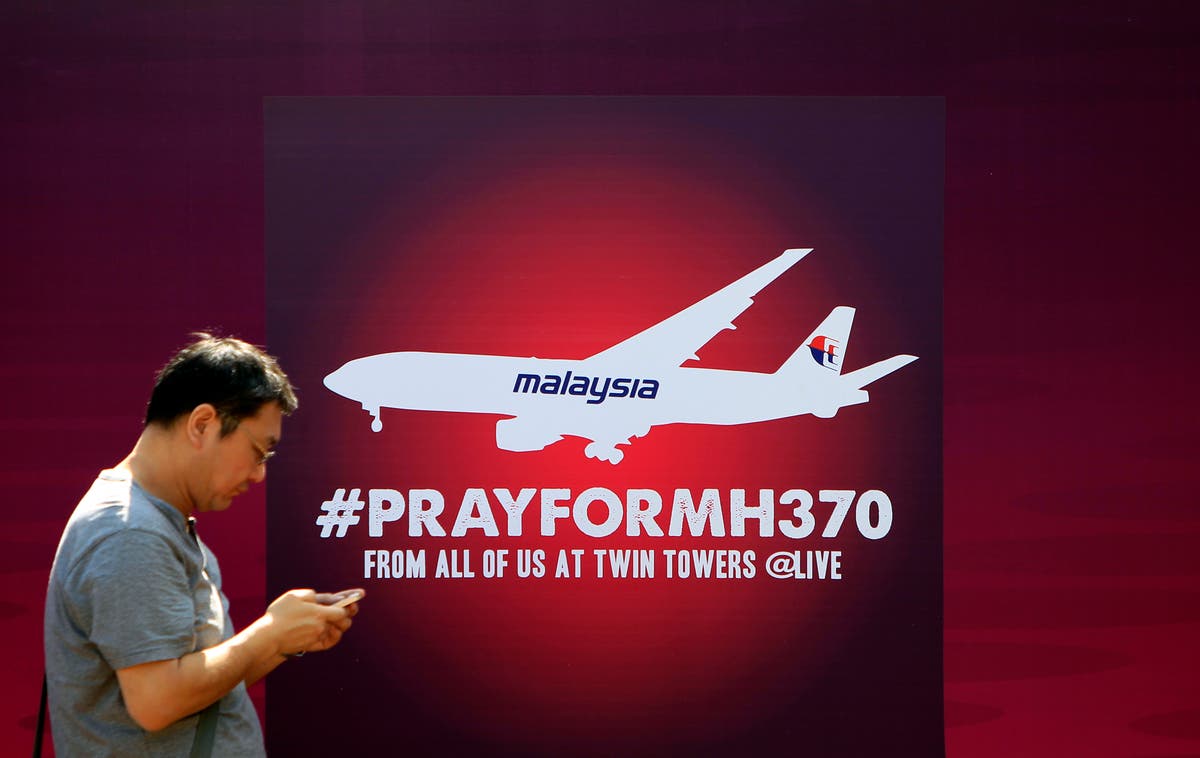MH370: 10 years on, what we know – and what we don’t – about the vanishing Malaysia Airlines jet
239 passengers and crew aboard the Boeing 777 disappeared on 8 March 2014


Sign up to Simon Calder’s free travel email for expert advice and money-saving discounts
Get Simon Calder’s Travel email
Late at night on 7 March 2014, 227 passengers and a dozen crew members boarded a Malaysia AirlinesBoeing 777 at Kuala Lumpur airport. They were expecting to travel overnight to Beijing on a flight designated MH370.
That flight number has become shorthand for the deepest mystery in aviation history. The relatives of the victims have endured 10 years of not knowing of the fate of their loved ones.
Air-traffic controllers lost contact with the jet while it was over the South China Sea. Over the following weeks, painstaking analysis of radar tracking and a succession of satellite “pings” showed that the jet veered off course and flew west over the South East Asia peninsula before turning south over the Indian Ocean.
When a passenger aircraft disappears over the sea, there is a well-established method for finding the plane: calculating the likely path, looking for debris on the surface of the water and searching the sea bed in a narrowly defined area. That was how the 2009 wreck of Air France flight AF447 was located in the Atlantic. The so-called “black boxes” revealed the tragic series of pilot errors that led to the loss of 228 lives aboard the Rio-Paris flight over the Atlantic. An inexperienced pilot reacted calamitously to a perfectly survivable set of technical failures.
The flight data recorder and cockpit voice recorder of MH370, together with deducing who was on the flight deck, may provide equally valuable evidence about the fate of the aircraft – and, more importantly, provide some closure for the families and loved ones of the victims.
Yet finding the aircraft has defeated the entire transport safety community. Inevitably, the vacuum has been filled with speculation. Many theories are easily dismissed: a North Korean missile did not down MH370, and nor is the aircraft hidden in a hangar in Kazakhstan.
But that leaves an ocean of possibilities.
Were there actually more than 239 people aboard when the Boeing took off from Kuala Lumpur? Communication with air-traffic controllers was lost, possibly deliberately: did someone deliberately divert the aircraft and crash the 777 into the sea? Or did it simply wander off course and run out of fuel?
Locating the lost aircraft could help to solve the mystery. But after 10 years and an exhaustive search of a patch of the Indian Ocean by Australian investigators, all we have to go on is a scattering of debris washed up on beaches.
Nineteen accident investigators concluded in the official report into the tragedy: “The team is unable to determine the real cause for the disappearance of MH370.”
These are the key questions; many of the answers are still unknown.
What was the sequence of events?
The Malaysia Airlines jet took off normally from Kuala Lumpur on a routine flight to Beijing. The manifest showed there was 239 people on board (though some speculate there may have been at least one more, hiding in an under-floor bay before perpetrating an act of mass murder).
The first the world knew that anything was wrong was when air-traffic controllers in Vietnam were unable to make contact with the Boeing 777.
After much confusion and some fictitious reports that it had diverted over Cambodia or landed in southern China with technical problems, MH370 was declared missing. The plane was presumed to have crashed in the South China Sea.
For a week, rescuers conducted a fruitless search in the waters between Malaysia and Vietnam. Then, at a dramatic press conference in Kuala Lumpur, the Malaysian prime minister, Najib Razak, announced that the aircraft had remained aloft for hours after it disappeared.
What did we discover about where the aircraft might be?
The only available evidence is based on painstaking analysis of satellite “pings” transmitted automatically from the aircraft each hour until it crashed. The aircraft was calculated to be somewhere near the so-called “Seventh Arc” off the west coast off Australia.
From an Australian air force base north of Perth, reconnaissance flights began of the presumed crash area. Plans were made for two unprecedented, and ultimately unsuccessful, sweeps of the seabed.
A few fragments of the aircraft started washing up on Indian Ocean beaches. But even after analysis of the species of barnacles that had grown up on the aircraft’s “flaperon”, investigators were no closer to locating the wreckage.
Was a pilot responsible?
Investigators have evaluated many explanations to explain the disappearance. All of them have deep flaws. Perhaps the least unlikely is that the aircraft’s commander, Captain Zaharie Shah, intentionally hijacked his own aircraft in order either to take his own life and kill everyone on board, or to land and ditch the plane and survive.
A common theory is that Captain Shah locked the first officer out of the flight deck. He switched off the communications systems that were designed to keep MH370 in touch with air-traffic controllers; donned an oxygen mask; and depressurised the aircraft.
At an altitude higher than Everest, the passengers and other crew would soon perish from from oxygen deficiency (hypoxia).
The captain then, the theory goes, flew the aircraft along the frontier between Thailand and Malaysia to avoid raising the interest of the military on either side, before turning south to a location where he believed it would never be found.
But the official report says: “There was no known history of apathy, anxiety, or irritability. There were no significant changes in his lifestyle, interpersonal conflict or family stresses.”
The first officer was 27-year-old Fariq Abdul Hamid. He was on his first Boeing 777 mission without a training captain overseeing him, and had flown the aircraft only five times before. The investigators said his “ability and professional approach to work was reported to be good”. It seems unlikely that someone with such limited experience of the aircraft would be able to pull off such a plan.
While sadly there have been a number of crashes perpetrated by suicidal pilots – notably the tragic destruction of Germanwings flight 9525 from Barcelona to Dusseldorf, in which the first officer killed himself and 150 others – never has the subsequent crash been so delayed from the moment of seizure.
Besides, the investigators concluded: “There is no evidence to suggest that the PIC [pilot in command, ie captain] and FO [first officer] experienced recent changes or difficulties in personal relationships or that there were any conflicts or problems between them.
“There had been no financial stress or impending insolvency, recent or additional insurance coverage purchased or recent behavioural changes for the crew.”
The investigators also analysed both pilots’ radio conversations and say they detected “no evidence of anxiety or stress”.
What do the experts think lies behind the disappearance of MH370?
The man who led the Australian Transport Safety Bureau’s two-year search of the seabed, Martin Dolan, says the act was carefully planned: “This was deliberate, and it was done over an extended period of time.”
The aviation security guru, Philip Baum, concurs: “Most agencies are confident that the loss of MH370 was the result of a criminal act and that the aircraft was deliberately, and manually, made to divert from its intended flight plan,” he told me.
“The question then arises as to who carried out the act and where they were at the time?”
What is his hunch?
“I still believe that pilot-assisted suicide is the most likely cause of the loss as that would explain almost every aspect of the diversion and the even the lack of proof for any of the alternative scenarios emerging.
“All the other scenarios would involve at least one other person being in-the-know, except the stowaway who could also have acted completely independently. And for that reason, I still think the stowaway scenario is a strong possibility.”
This theory is that a stowaway concealed in the avionics bay by the flight deck seized control, either in a suicidal mission or with the futile intention of landing at a remote island.
Could a passenger or member of cabin crew be responsible?
Given the large number of passengers onboard, as well as 10 cabin crew, there is a wide range of possible motives. Standard aviation security measures were in place at Kuala Lumpur International Airport. As the tragic events of 9/11 showed, the fact of having passed through a checkpoint does not mean that the passenger poses no threat to the aircraft and the people onboard.
There were a total of 227 passengers (including three children and two infants) on board, with the majority of them from China, followed by Malaysia.
Two Iranian passengers were travelling on passports stolen from an Italian and an Austrian respectively, but they appear to have been illegal migrants who were keen to reach the West rather than harbouring any malicious intent.
All 10 members of cabin crew were married with children, which some have said implies they were unlikely to have hijacked the aircraft.
And will we ever know?
“I do have some degree of confidence that the wreckage will be found and that the cause will eventually become known. Just not sure if that will be in my lifetime,” says aviation security expert Philip Baum.
For more travel news, views and advice from Simon, download his daily Independent Travel podcast.

 Konoly
Konoly 






























